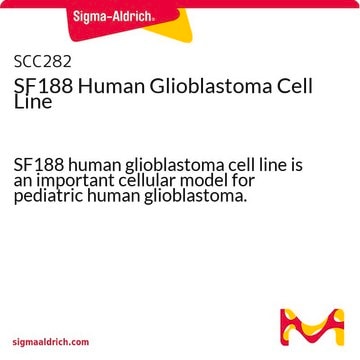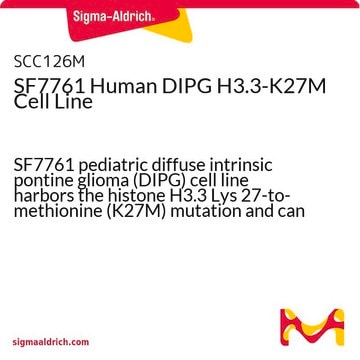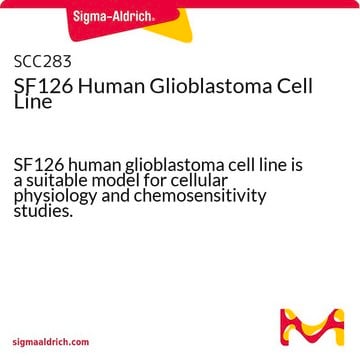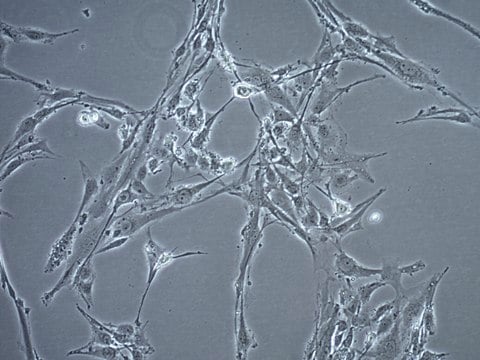SCC127M
SF8628 Human DIPG H3.3-K27M Cell Line
Human
Sinônimo(s):
SF-8628 cells
About This Item
Produtos recomendados
product name
SF8628 Human DIPG H3.3-K27M Cell Line, SF8628 pediatric diffuse intrinsic pontine glioma (DIPG) cell line harbors the histone H3.3 Lys 27-to-methionine (K27M) mutation and can support research and drug development efforts targeting DIPG.
fonte biológica
human
Nível de qualidade
técnica(s)
cell culture | mammalian: suitable
Descrição geral
A somatic mutation of histone H3.3 resulting in a lysine 27 to methionine substitution (H3.3K27M) occurs in 60% of DIPG (2). In H3.3K27M DIPG patient samples, levels of H3K27 dimethylation (H3K27me2) and trimethylation (H3K27me3) are reduced globally. These epigenetic changes are thought to be important factors driving DIPG oncogenesis (2,3,4). Expression of H3.3K27M was also recently shown to be associated with increased levels of H3K27 acetylation (H3K27ac) and recruitment of bromodomain proteins at sites of active transcription (5). Treatment of H3.3K27M DIPG cells with a bromodomain and extra-terminal domain (BET) inhibitor was found to inhibit proliferation and induced differentiation. BET inhibitors are thus a promising therapeutic approach for the treatment of DIPG.
1. Schroeder KM et al. (2014) Pediatr. Res. 75(1-2): 205–209.
2. Lewis PW et al. (2013) Science 340(6134): 857–861.
3. Chan K-M et al. (2013) Genes & Development 27: 985-990.
4. Hashizume R et al. (2014) Nat Med. 20(12):1394-6.
5. Piunti A et al. (2017) Nat. Med. 23(4): 493-500.
6. Mueller S et al. (2014) Neuro Oncol. 16(3): 352-360.
Descrição de linhagem celular
Aplicação
Cancer
Oncology
Qualidade
• Cells are tested negative for Epstein-Barr virus, HPV-16, HPV-18, Hepatitis A, C, Herpesvirus type 6, 7, 8 and HIV-1 & 2 viruses by PCR
• Cells are negative for mycoplasma contamination.
• Each lot of cells is genotyped by STR analysis to verify the unique identity of the cell line
Armazenamento e estabilidade
Exoneração de responsabilidade
Código de classe de armazenamento
10 - Combustible liquids
Classe de risco de água (WGK)
WGK 2
Ponto de fulgor (°F)
Not applicable
Ponto de fulgor (°C)
Not applicable
Certificados de análise (COA)
Busque Certificados de análise (COA) digitando o Número do Lote do produto. Os números de lote e remessa podem ser encontrados no rótulo de um produto após a palavra “Lot” ou “Batch”.
Já possui este produto?
Encontre a documentação dos produtos que você adquiriu recentemente na biblioteca de documentos.
Nossa equipe de cientistas tem experiência em todas as áreas de pesquisa, incluindo Life Sciences, ciência de materiais, síntese química, cromatografia, química analítica e muitas outras.
Entre em contato com a assistência técnica








